oil capacity MERCEDES-BENZ M-Class 2015 W166 Owner's Manual
[x] Cancel search | Manufacturer: MERCEDES-BENZ, Model Year: 2015, Model line: M-Class, Model: MERCEDES-BENZ M-Class 2015 W166Pages: 466, PDF Size: 8.92 MB
Page 13 of 466
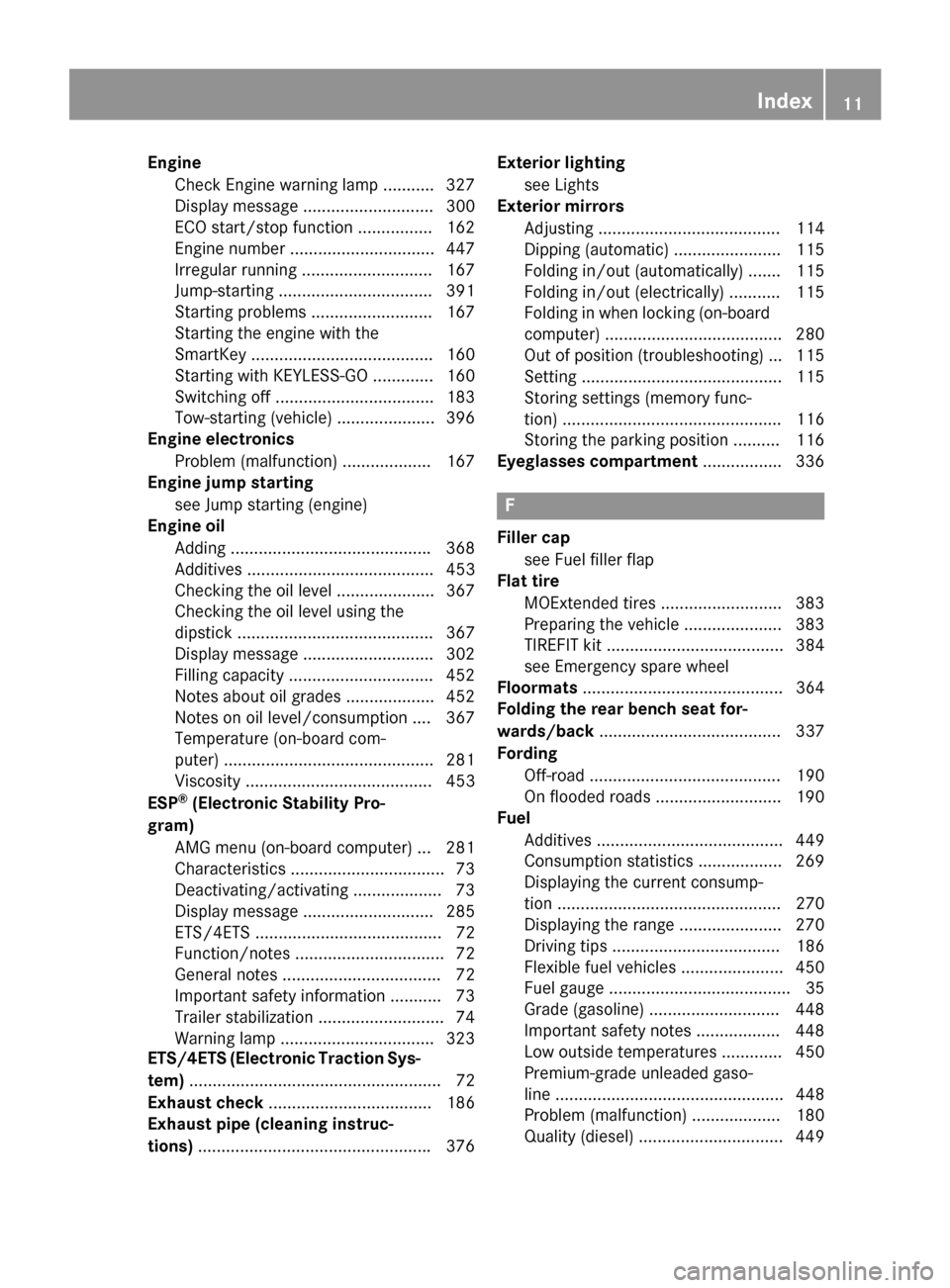
Engine
Check Engine warning lamp .......... .327
Display message ............................ 300
ECO start/stop function ................ 162
Engine number ............................... 447
Irregular running ............................ 167
Jump-starting ................................. 391
Starting problems .......................... 167
Starting the engine with the
SmartKey ....................................... 160
Starting with KEYLESS-GO ............. 160
Switching off .................................. 183
Tow-starting (vehicle) ..................... 396
Engine electronics
Problem (malfunction) ................... 167
Engine jump starting
see Jump starting (engine)
Engine oil
Adding .......................................... .368
Additives ........................................ 453
Checking the oil level ..................... 367
Checking the oil level using the
dipstick .......................................... 367
Display message ............................ 302
Filling capacity ............................... 452
Notes about oil grades ................... 452
Notes on oil level/consumption .... 367
Temperature (on-board com-
puter) ............................................. 281
Viscosity ........................................ 453
ESP ®
(Electronic Stability Pro-
gram) AMG menu (on-board computer) ... 281
Characteristics ................................. 73
Deactivating/activating ................... 73
Display message ............................ 285
ETS/4ETS ........................................ 72
Function/notes ................................ 72
General notes .................................. 72
Important safety information ........... 73
Trailer stabilization ........................... 74
Warning lamp ................................. 323
ETS/4ETS (Electronic Traction Sys-
tem) ...................................................... 72
Exhaust check ................................... 186
Exhaust pipe (cleaning instruc-
tions) ................................................. .376 Exterior lighting
see Lights
Exterior mirrors
Adjusting ....................................... 114
Dipping (automatic) ....................... 115
Folding in/out (automatically) ....... 115
Folding in/out (electrically) ........... 115
Folding in when locking (on-board computer) ...................................... 280
Out of position (troubleshooting) ... 115
Setting ........................................... 115
Storing settings (memory func-
tion) ............................................... 116
Storing the parking position .......... 116
Eyeglasses compartment ................. 336 F
Filler cap see Fuel filler flap
Flat tire
MOExtended tire s.......................... 383
Preparing the vehicle ..................... 383
TIREFIT kit ...................................... 384
see Emergency spare wheel
Floormats ........................................... 364
Folding the rear bench seat for-
wards/back ....................................... 337
Fording Off-road ......................................... 190
On flooded roads ........................... 190
Fuel
Additives ........................................ 449
Consumption statistics .................. 269
Displaying the current consump-
tion ................................................ 270
Displaying the range ...................... 270
Driving tips .................................... 186
Flexible fuel vehicles ...................... 450
Fuel gaug e....................................... 35
Grade (gasoline )............................ 448
Important safety notes .................. 448
Low outside temperature s............. 450
Premium-grade unleaded gaso-
line ................................................. 448
Problem (malfunction) ................... 180
Quality (diesel )............................... 449 Index
11
Page 424 of 466
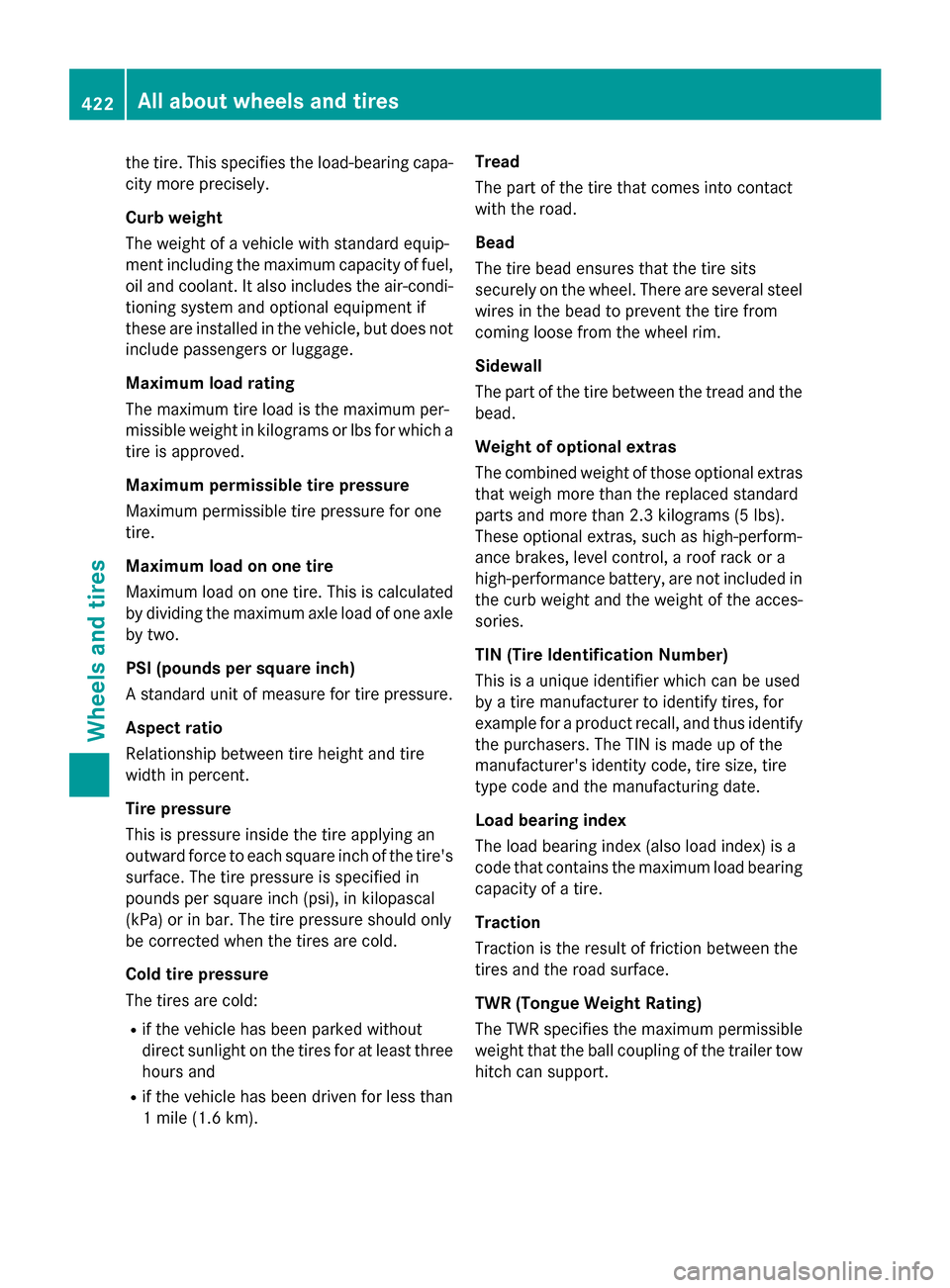
the tire. This specifies the load-bearing capa-
city more precisely.
Curb weight
The weight of a vehicle with standard equip-
ment including the maximum capacity of fuel,
oil and coolant. It also includes the air-condi- tioning system and optional equipment if
these are installed in the vehicle, but does notinclude passengers or luggage.
Maximum load rating
The maximum tire load is the maximum per-
missible weight in kilograms or lbs for which a
tire is approved.
Maximum permissible tire pressure
Maximum permissible tire pressure for one
tire.
Maximum load on one tire
Maximum load on one tire. This is calculated
by dividing the maximum axle load of one axle
by two.
PSI (pounds per square inch)
A standard unit of measure for tire pressure.
Aspect ratio
Relationship between tire height and tire
width in percent.
Tire pressure
This is pressure inside the tire applying an
outward force to each square inch of the tire's surface. The tire pressure is specified in
pounds per square inch (psi), in kilopascal
(kPa) or in bar. The tire pressure should only
be corrected when the tires are cold.
Cold tire pressure
The tires are cold:
R if the vehicle has been parked without
direct sunlight on the tires for at least three
hours and
R if the vehicle has been driven for less than
1 mile (1.6 km). Tread
The part of the tire that comes into contact
with the road.
Bead
The tire bead ensures that the tire sits
securely on the wheel. There are several steel
wires in the bead to prevent the tire from
coming loose from the wheel rim.
Sidewall
The part of the tire between the tread and the bead.
Weight of optional extras
The combined weight of those optional extras
that weigh more than the replaced standard
parts and more than 2.3 kilograms (5 lbs).
These optional extras, such as high-perform-
ance brakes, level control, a roof rack or a
high-performance battery, are not included in the curb weight and the weight of the acces-
sories.
TIN (Tire Identification Number)
This is a unique identifier which can be used
by a tire manufacturer to identify tires, for
example for a product recall, and thus identify
the purchasers. The TIN is made up of the
manufacturer's identity code, tire size, tire
type code and the manufacturing date.
Load bearing index
The load bearing index (also load index) is a
code that contains the maximum load bearing capacity of a tire.
Traction
Traction is the result of friction between the
tires and the road surface.
TWR (Tongue Weight Rating)
The TWR specifies the maximum permissible
weight that the ball coupling of the trailer tow
hitch can support. 422
All about
wheels and tiresWheels and tires
Page 454 of 466
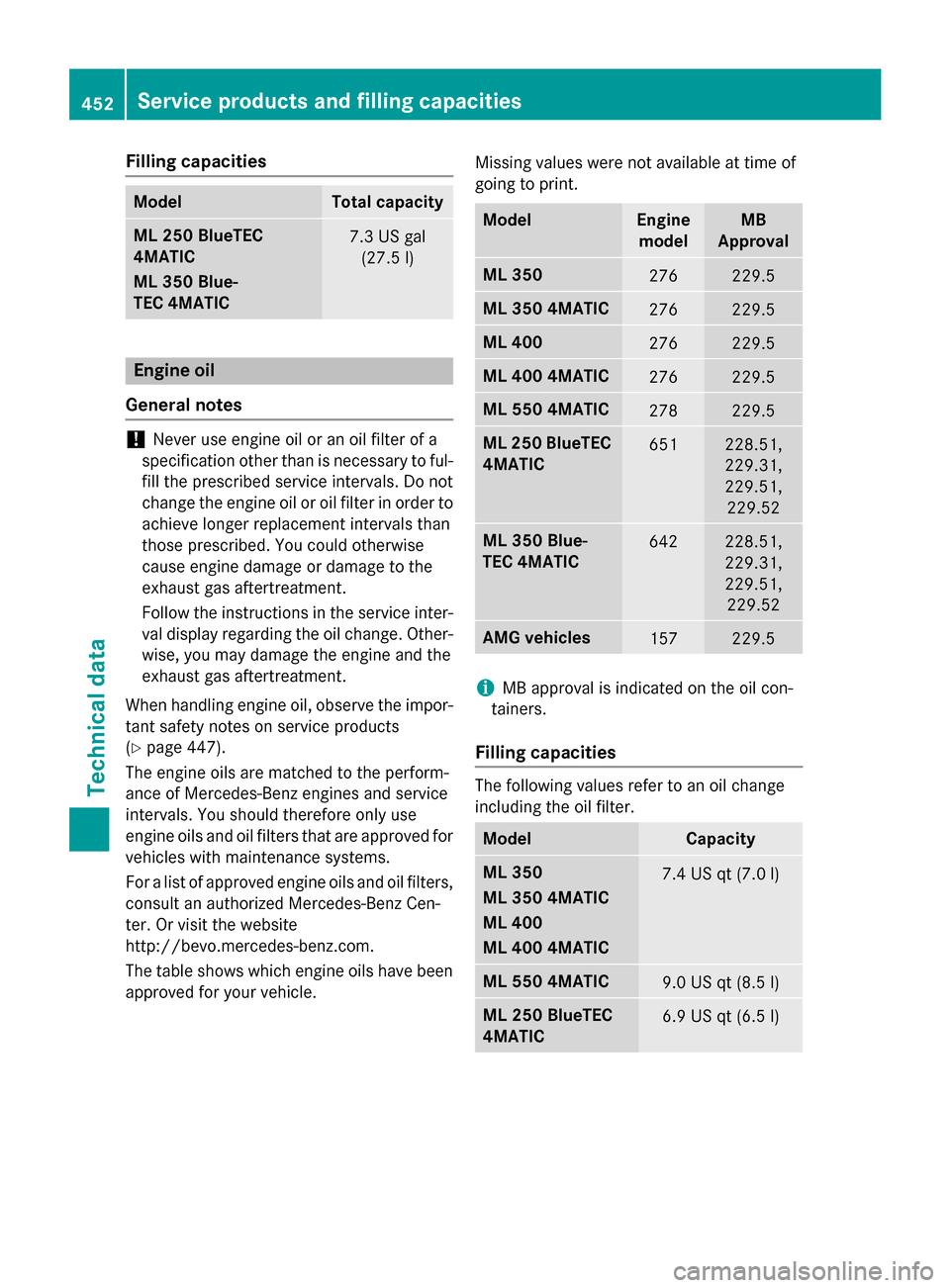
Filling capacities
Model Total capacity
ML 250 BlueTEC
4MATIC
ML 350 Blue-
TEC 4MATIC
7.3 US gal
(27.5 l) Engine oil
General notes !
Never use engine oil or an oil filter of a
specification other than is necessary to ful- fill the prescribed service intervals. Do not
change the engine oil or oil filter in order to
achieve longer replacement intervals than
those prescribed. You could otherwise
cause engine damage or damage to the
exhaust gas aftertreatment.
Follow the instructions in the service inter-
val display regarding the oil change. Other-
wise, you may damage the engine and the
exhaust gas aftertreatment.
When handling engine oil, observe the impor- tant safety notes on service products
(Y page 447).
The engine oils are matched to the perform-
ance of Mercedes-Benz engines and service
intervals. You should therefore only use
engine oils and oil filters that are approved for vehicles with maintenance systems.
For a list of approved engine oils and oil filters, consult an authorized Mercedes-Benz Cen-
ter. Or visit the website
http://bevo.mercedes-benz.co m.
The table shows which engine oils have been
approved for your vehicle. Missing values were not available at time of
going to print. Model Engine
model MB
Approval ML 350
276 229.5
ML 350 4MATIC
276 229.5
ML 400
276 229.5
ML 400 4MATIC
276 229.5
ML 550 4MATIC
278 229.5
ML 250 BlueTEC
4MATIC 651 228.51,
229.31,
229.51,
229.52 ML 350 Blue-
TEC 4MATIC
642 228.51,
229.31,
229.51,
229.52 AMG vehicles
157 229.5
i
MB approval is indicated on the oil con-
tainers.
Filling capacities The following values refer to an oil change
including the oil filter. Model Capacity
ML 350
ML 350 4MATIC
ML 400
ML 400 4MATIC
7.4 US qt (7.0
l) ML 550 4MATIC
9.0 US qt (8.5
l) ML 250 BlueTEC
4MATIC
6.9 US qt (6.5
l)452
Service products and filling capacitiesTechnical data
Page 455 of 466
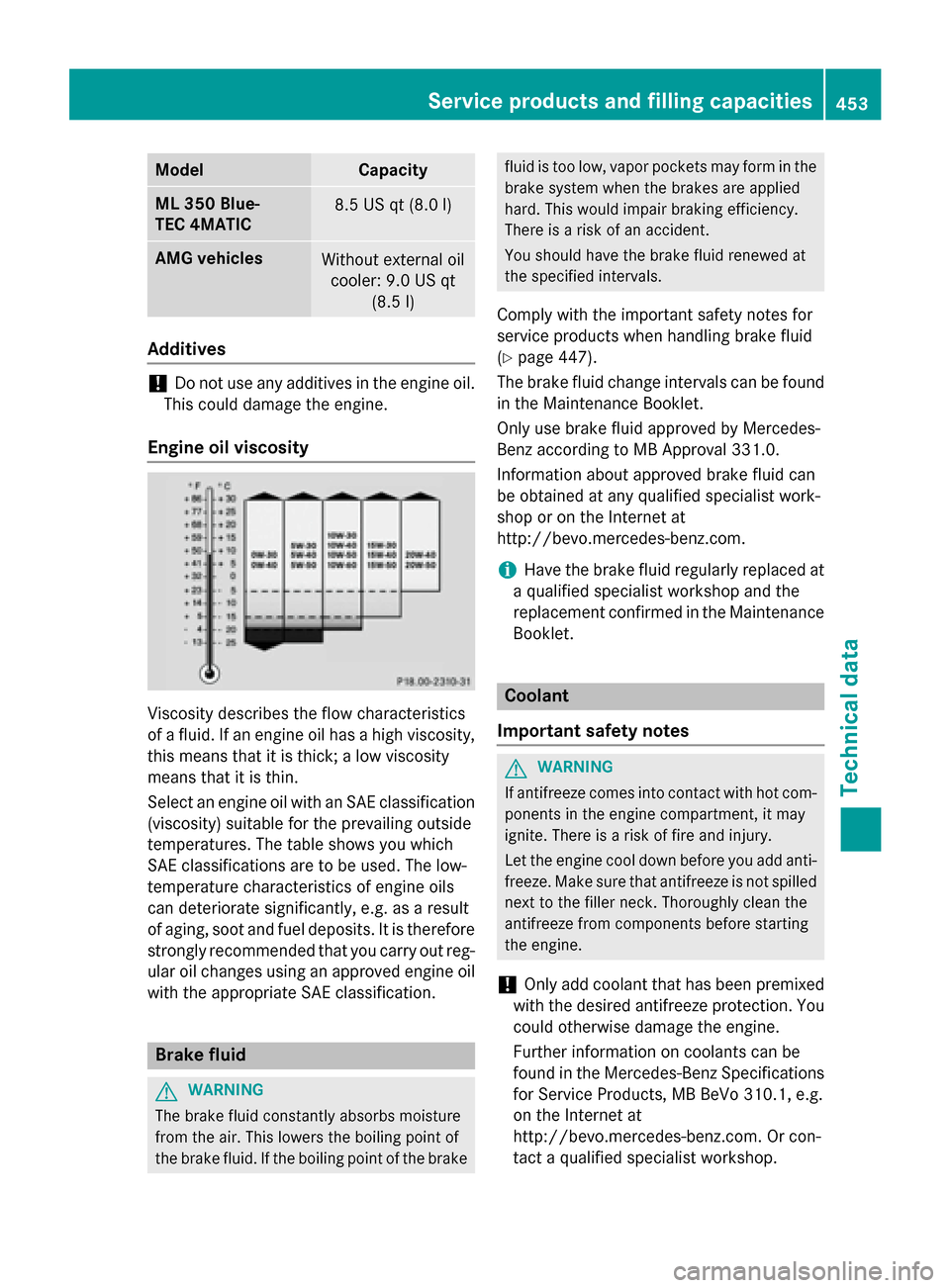
Model Capacity
ML 350 Blue-
TEC 4MATIC
8.5 US qt (8.0
l) AM
G vehicles Without external oil
cooler: 9.0 US qt (8.5l) Ad
ditives !
Do not use any additives in the engine oil.
This could damage the engine.
Engine oil viscosity Viscosity describes the flow characteristics
of a fluid. If an engine oil has a high viscosity, this means that it is thick; a low viscosity
means that it is thin.
Select an engine oil with an SAE classification (viscosity) suitable for the prevailing outside
temperatures. The table shows you which
SAE classifications are to be used. The low-
temperature characteristics of engine oils
can deteriorate significantly, e.g. as a result
of aging, soot and fuel deposits. It is therefore
strongly recommended that you carry out reg- ular oil changes using an approved engine oil
with the appropriate SAE classification. Brake fluid
G
WARNING
The brake fluid constantly absorbs moisture
from the air. This lowers the boiling point of
the brake fluid. If the boiling point of the brake fluid is too low, vapor pockets may form in the
brake system when the brakes are applied
hard. This would impair braking efficiency.
There is a risk of an accident.
You should have the brake fluid renewed at
the specified intervals.
Comply with the important safety notes for
service products when handling brake fluid
(Y page 447).
The brake fluid change intervals can be found
in the Maintenance Booklet.
Only use brake fluid approved by Mercedes-
Benz according to MB Approval 331.0.
Information about approved brake fluid can
be obtained at any qualified specialist work-
shop or on the Internet at
http://bevo.mercedes-benz.com.
i Have the brake fluid regularly replaced at
a qualified specialist workshop and the
replacement confirmed in the Maintenance Booklet. Coolant
Important safety notes G
WARNING
If antifreeze comes into contact with hot com- ponents in the engine compartment, it may
ignite. There is a risk of fire and injury.
Let the engine cool down before you add anti-
freeze. Make sure that antifreeze is not spilled
next to the filler neck. Thoroughly clean the
antifreeze from components before starting
the engine.
! Only add coolant that has been premixed
with the desired antifreeze protection. You
could otherwise damage the engine.
Further information on coolants can be
found in the Mercedes-Benz Specifications for Service Products, MB BeVo 310.1, e.g.
on the Internet at
http://bevo.mercedes-benz.com. Or con-
tact a qualified specialist workshop. Service products and filling capacities
453Technical data Z
Page 456 of 466
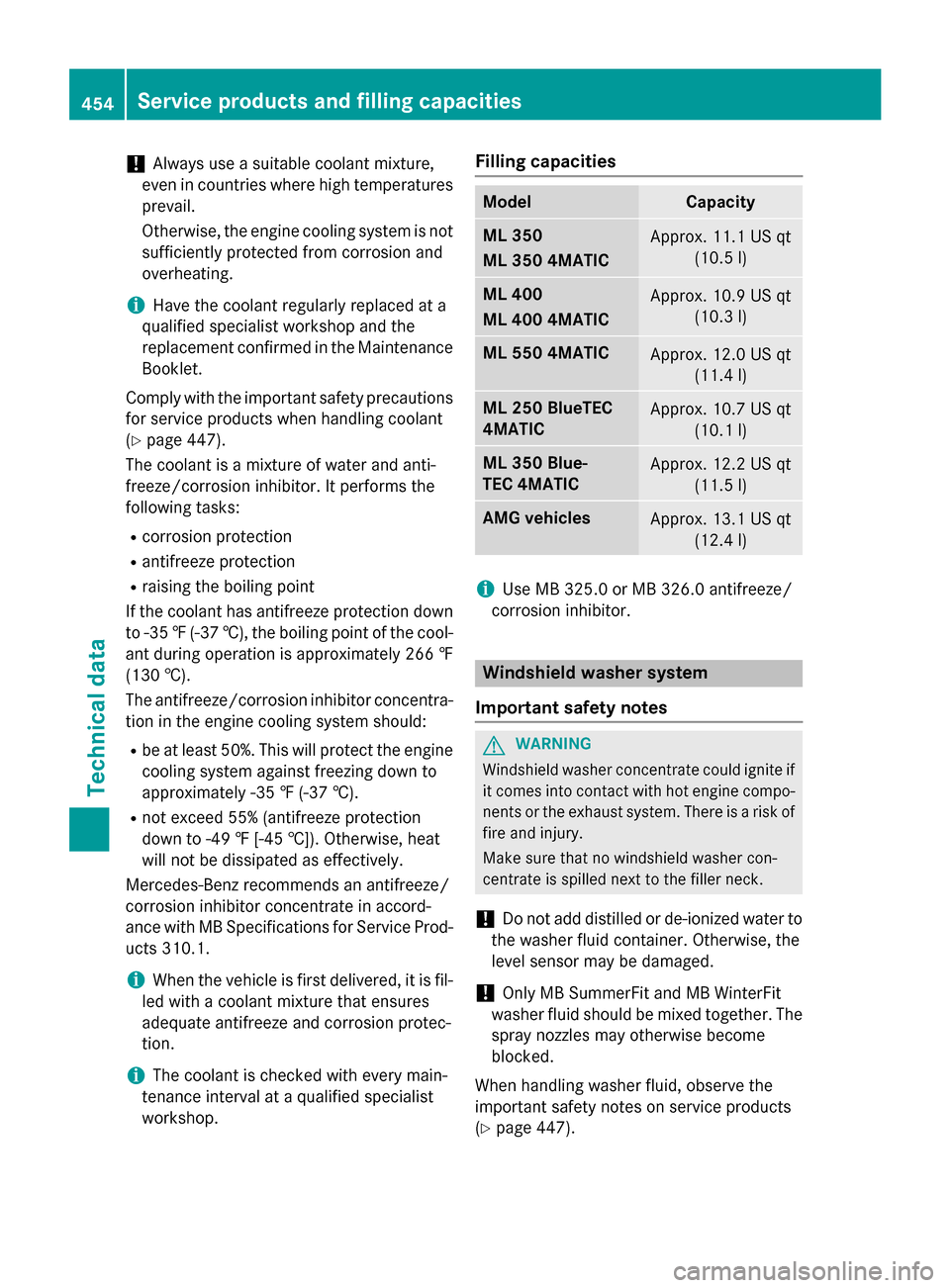
!
Always use a suitable coolant mixture,
even in countries where high temperatures prevail.
Otherwise, the engine cooling system is not
sufficiently protected from corrosion and
overheating.
i Have the coolant regularly replaced at a
qualified specialist workshop and the
replacement confirmed in the Maintenance Booklet.
Comply with the important safety precautions
for service products when handling coolant
(Y page 447).
The coolant is a mixture of water and anti-
freeze/corrosion inhibitor. It performs the
following tasks:
R corrosion protection
R antifreeze protection
R raising the boiling point
If the coolant has antifreeze protection down to -35 ‡(-37 †), the boiling point of the cool-
ant during operation is approximately 266 ‡
(130 †).
The antifreeze/corrosion inhibitor concentra- tion in the engine cooling system should:
R be at least 50%. This will protect the engine
cooling system against freezing down to
approximately -35 ‡(-37 †).
R not exceed 55% (antifreeze protection
do wn to -49 ‡ [-45 †]). Otherwise, heat
will not be dissipated as effectively.
Mercedes-Benz recommends an antifreeze/
corrosion inhibitor concentrate in accord-
ance with MB Specifications for Service Prod-
ucts 310.1.
i When the vehicle is first delivered, it is fil-
led with a coolant mixture that ensures
adequate antifreeze and corrosion protec-
tion.
i The coolant is checked with every main-
tenance interval at a qualified specialist
workshop. Filling capacities Model Capacity
ML 350
ML 350 4MATIC
Approx. 11.1 US qt
(10.5 l) ML 400
ML 400 4MATIC
Approx. 10.9 US qt
(10.3 l) ML 550 4MATIC
Approx. 12.0 US qt
(11.4 l) ML 250 BlueTEC
4MATIC
Approx. 10.7 US qt
(10.1 l) ML 350 Blue-
TEC 4MATIC
Approx. 12.2 US qt
(11.5 l) AMG vehicles
Approx. 13.1 US qt
(12.4 l) i
Use MB 325.0 or MB 326.0 antifreeze/
corrosion inhibitor. Windshield washer system
Important safety notes G
WARNING
Windshield washer concentrate could ignite if it comes into contact with hot engine compo-
nents or the exhaust system. There is a risk of
fire and injury.
Make sure that no windshield washer con-
centrate is spilled next to the filler neck.
! Do not add distilled or de-ionized water to
the washer fluid container. Otherwise, the
level sensor may be damaged.
! Only MB SummerFit and MB WinterFit
washer fluid should be mixed together. The
spray nozzles may otherwise become
blocked.
When handling washer fluid, observe the
important safety notes on service products
(Y page 447). 454
Service products and filling capacitiesTechnical data
Page 457 of 466
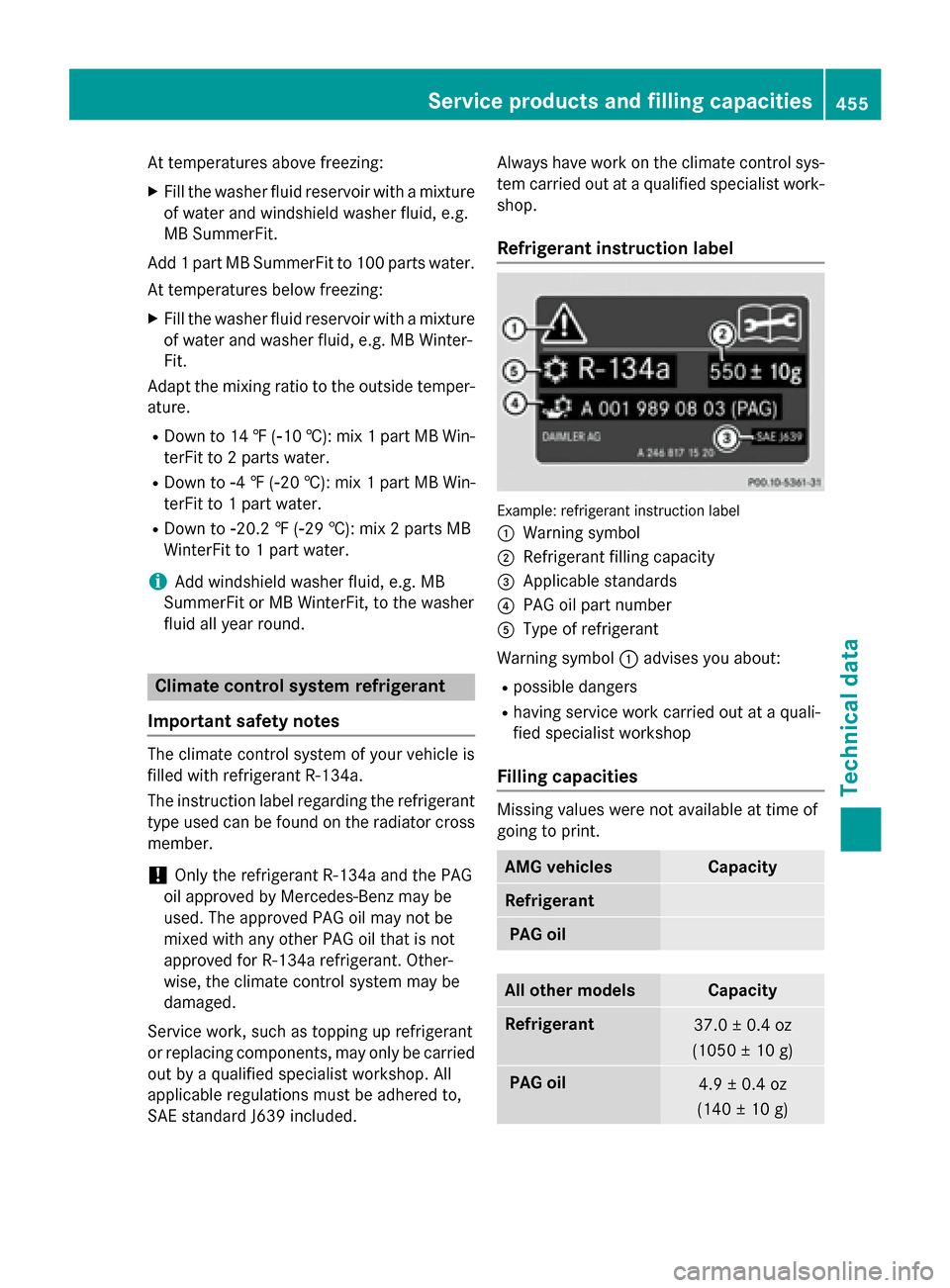
At temperatures above freezing:
X Fill the washer fluid reservoir with a mixture
of water and windshield washer fluid, e.g.
MB SummerFit.
Add 1 part MB SummerFit to 100 parts water.
At temperatures below freezing:
X Fill the washer fluid reservoir with a mixture
of water and washer fluid, e.g. MB Winter-
Fit.
Adapt the mixing ratio to the outside temper-
ature.
R Down to 14 ‡ (00F8 10 †): mix 1 part MB Win-
terFit to 2 parts water.
R Down to 00F84 ‡ (00F820 †): mix 1 part MB Win-
terFit to 1 part water.
R Down to 00F820.2 ‡ (00F8 29 †): mix 2 parts MB
WinterFit to 1 part water.
i Add windshield washer fluid, e.g. MB
SummerFit or MB WinterFit, to the washer
fluid all year round. Climate control system refrigerant
Important safety notes The climate control system of your vehicle is
filled with refrigerant R
‑134a.
The instruction label regarding the refrigerant
type used can be found on the radiator cross
member.
! Only the refrigerant R‑134a and the PAG
oil approved by Mercedes-Benz may be
used. The approved PAG oil may not be
mixed with any other PAG oil that is not
approved for R-134a refrigerant. Other-
wise, the climate control system may be
damaged.
Service work, such as topping up refrigerant
or replacing components, may only be carried
out by a qualified specialist workshop. All
applicable regulations must be adhered to,
SAE standard J639 included. Always have work on the climate control sys-
tem carried out at a qualified specialist work-
shop.
Refrigerant instruction label Example: refrigerant instruction label
0043 Warning symbol
0044 Refrigerant filling capacity
0087 Applicable standards
0085 PAG oil part number
0083 Type of refrigerant
Warning symbol 0043advises you about:
R possible dangers
R having service work carried out at a quali-
fied specialist workshop
Filling capacities Missing values were not available at time of
going to print.
AMG vehicles Capacity
Refrigerant
PAG oil
All other models Capacity
Refrigerant
37.0 ± 0.4 oz
(1050 ± 10 g) PA
G oil 4.9 ± 0.4 oz
(140 ± 10 g) Se
rvi ce products and filling capacities
455Technical da ta Z